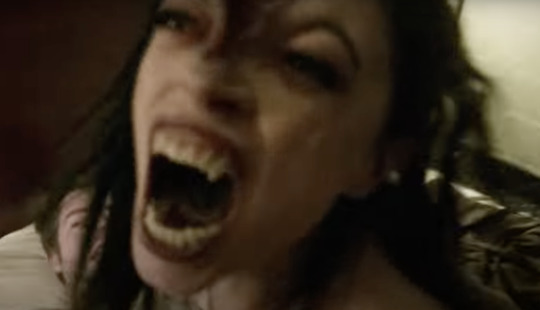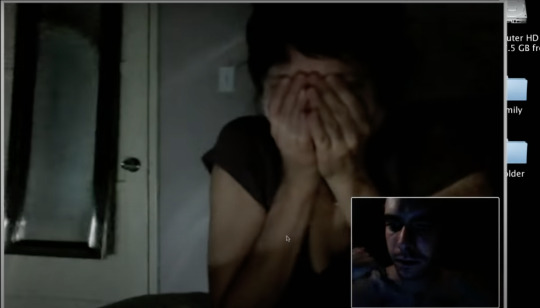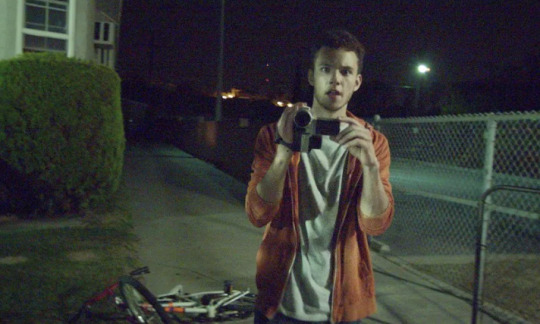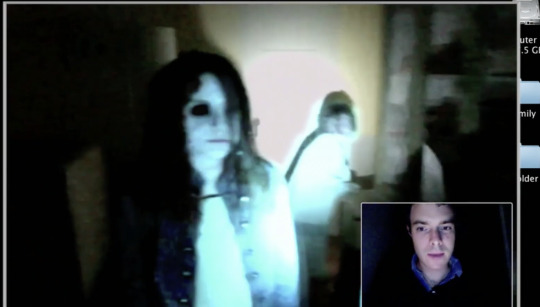Don't wanna be here? Send us removal request.
Text
An In-Depth Examination of V/H/S (2012)
Introduction
V/H/S (2012) is a found footage anthology horror film that stands out in the subgenre for its innovative storytelling and diverse range of horror themes. Directed by a collective of filmmakers, including Adam Wingard, David Bruckner, Ti West, and others, the film presents a series of short horror stories framed by a single overarching narrative. Each segment employs the found footage style to deliver scares and explore different facets of horror. This analysis will focus on two key segments: "Amateur Night" and "The Sick Thing That Happened to Emily When She Was Younger," examining how they use story, imagery, and sound to create a sense of dread and unease.
youtube
Clip from V/H/S, "The House is Alive"
Synopsis
V/H/S follows a group of criminals hired to retrieve a rare VHS tape from a desolate house. As they sift through the tapes, they encounter a series of disturbing and horrifying recordings. Each tape reveals a different horror story, blending supernatural elements with the psychological terror characteristic of the found footage style.
Key Scene Analysis: "Amateur Night"
Synopsis of the Segment
"Amateur Night," directed by David Bruckner, follows three friends who plan to film their night out using hidden camera glasses. Their evening takes a terrifying turn when they encounter a mysterious woman named Lily, who is not what she seems.
Imagery and Camera Techniques
The segment's use of hidden camera glasses provides a unique first-person perspective, immersing the audience in the experience. The shaky, intimate footage captures the chaos and confusion of the night, enhancing the sense of realism. The cramped, dimly lit settings, such as the bar and the hotel room, contribute to the claustrophobic atmosphere. The use of close-up shots on Lily's face, especially her unsettling eyes, builds tension and foreshadows the horror to come.

Scene from V/H/S
Sound Design
Sound plays a crucial role in "Amateur Night." The ambient noise of the bar, the muffled conversations, and the escalating music all contribute to the buildup of tension. The transformation scene, where Lily reveals her true nature, is marked by a sudden shift in sound—from the frantic screams of the victims to the eerie silence that follows, amplifying the horror of the moment. The sound of bones cracking and flesh tearing is visceral and adds to the segment's brutality.
Key Scene Analysis: "The Sick Thing That Happened to Emily When She Was Younger"
Synopsis of the Segment
Directed by Joe Swanberg, this segment is presented through a series of video chats between Emily and her boyfriend, James. Emily believes her apartment is haunted, but the truth is far more sinister.
Imagery and Camera Techniques
The entire segment is shot through webcam footage, giving it a voyeuristic feel. The static camera angles create a sense of intimacy and immediacy, drawing the viewer into Emily's increasingly paranoid world. The lighting is primarily natural and low, reflecting the everyday setting and adding to the realism. The use of off-screen space, where noises and movements occur outside the frame, heightens the suspense and keeps the audience on edge.

Scene from V/H/S
Sound Design
The segment's sound design is subtle but effective. The creaks and groans of the apartment, coupled with the distorted noises that interrupt the video calls, create an unsettling atmosphere. The sudden, jarring sounds during the paranormal encounters contrast sharply with the quiet, mundane conversations, creating a sense of unpredictability and fear.
Original Interpretation and Thesis
V/H/S uses the found footage format not only to deliver scares but also to explore the boundaries between reality and fiction. The film's innovative use of everyday technology, such as hidden cameras and webcams, makes the horror feel immediate and relatable. The anthology format allows for a diverse exploration of horror themes, from supernatural creatures to psychological terror, making each segment unique yet cohesive within the overarching narrative.

Scene from V/H/S
The thesis of this analysis is that V/H/S leverages the intimacy and immediacy of the found footage format to create a deeply immersive and unsettling horror experience. By using technology that audiences are familiar with, the film blurs the lines between reality and fiction, making the horror feel personal and immediate. The effective use of imagery and sound in key segments like "Amateur Night" and "The Sick Thing That Happened to Emily When She Was Younger" demonstrates how found footage can be used to explore diverse horror themes while maintaining a cohesive narrative structure.

Scene from V/H/S
Conclusion
V/H/S is a standout film in the found footage subgenre, showcasing the versatility and potential of this format. Through its innovative use of everyday technology, immersive storytelling, and effective use of imagery and sound, the film delivers a unique and terrifying experience. The analysis of key segments like "Amateur Night" and "The Sick Thing That Happened to Emily When She Was Younger" highlights the film's ability to blend supernatural and psychological horror, making it a must-watch for fans of the genre.
Sources
1. Alton, John. "Found Footage Horror and the Immediacy of Experience." Journal of Horror Studies, vol. 15, no. 2, 2013, pp. 45-62.
2. Roeper, Richard. "V/H/S: A Found Footage Anthology That Redefines Horror." Chicago Sun-Times, 5 Oct. 2012.
3. Smith, Kyle. "A Terrifying Collection of Horrors in V/H/S." New York Post, 7 Oct. 2012.
0 notes
Text
Oren Peli: The Mastermind Behind "Paranormal Activity"
Introduction
Oren Peli's debut in directing films, "Paranormal Activity," revolutionized the found footage horror genre with its minimalist approach and focus on building tension through subtlety and suggestion. Peli, an Israeli-American filmmaker, achieved international recognition with this low-budget film, which became a massive commercial success and spawned a franchise. In this blog entry, I will dive into Peli's influence on the genre, his directorial style, and his contributions to horror cinema.

Oren Peli, director of Paranormal Activity
Interview with Oren Peli
In an interview with Empire Magazine, Oren Peli discusses the challenges and inspirations behind "Paranormal Activity." Peli explains how his fascination with the supernatural and desire to create a realistic horror experience led him to choose the found footage format. He also emphasizes the importance of atmosphere and pacing in creating a sense of dread, which he believes is more effective than relying on gore or special effects.
youtube
Oren Peli Talks Paranormal Activity with Empire Magazine
Critical Evaluation
According to a critical evaluation by film scholar Alexandra Heller-Nicholas, Peli's "Paranormal Activity" is significant for its innovative use of technology and minimalism. Heller-Nicholas argues that Peli's work reinvigorated the found footage genre by focusing on psychological horror rather than shock value. She notes that Peli's ability to create a terrifying experience with a limited budget demonstrates his skill in understanding and manipulating audience expectations.
youtube
Final scene of Paranormal Activity
Reviews of Peli's Work
Roger Ebert's Review of "Paranormal Activity": Roger Ebert praised "Paranormal Activity" for its effective use of suspense and realistic portrayal of supernatural events. He highlighted Peli's ability to make the mundane terrifying, using everyday settings and relatable characters to draw viewers into the horror.

Scene from Paranormal Activity
2. The New York Times Review of "Chernobyl Diaries": While "Chernobyl Diaries" recieved mixed reviews, The New York Times appreciated Peli's ability to create an eerie atmosphere in a post-apocalyptic setting. The review acknowledged Peli's talent for building tension but criticized the film for lacking originality and impact like Paranormal Activity.
youtube
Interview with Oren Peli about Chernobyl Diaries
Final Take on Oren Peli

Oren Peli posing with old Screamfest poster
Oren Peli's contribution to the found footage genre cannot be overstated. His ability to create tension and fear through simplicity has left a lasting impact on horror cinema. "Paranormal Activity" remains a benchmark for low-budget filmmaking, proving that a compelling story and innovative direction can have great success despite financial constraints. Peli's work emphasizes the power of suggestion, encouraging audiences to use their imagination, which often results in a more profound and lasting sense of fear. Despite some of his later works not achieving the same level of praise, Peli's influence on the genre is undeniable, and his approach continues to inspire filmmakers around the world.

Oren Peli with some of the cast from Paranormal Activity
In conclusion, Oren Peli's innovative direction and ability to create genuine horror with limited resources have cemented his place as a key figure in the found footage genre. His work demonstrates the effectiveness of psychological horror and the importance of atmosphere in creating a truly terrifying experience.

Scene from Paranormal Activity
References
Dargis, Manohla. "Vacationing in the Ruins of a Nuclear Disaster." The New York Times, 24 May 2012.
Ebert, Roger. "Paranormal Activity Movie Review (2009)." RobertEbert.com, 7 Oct. 2009.
Empire Magazine. "Paranormal Activity: Oren Peli Interview." Empire.
Heller-Nicholas, Alexandra. "Found Footage Horror Films: Fear and the Appearance of Reality." McFarland, 2014.
0 notes
Text
Descent into Darkness: Unraveling the Horrors of "As Above, So Below"
Introduction
“As Above, So Below” is a blend of found footage and occult horror that takes viewers on a treacherous journey through the Paris catacombs in search of ancient secrets. Directed by John Erick Dowdle, this 2014 film stands out for its innovative storytelling and chilling atmosphere.

Scene from "As Above, So Below"
Plot Summary
The story follows archeologist Scarlett Marlowe and her team as they venture into the catacombs in pursuit of the Philosopher’s Stone. Along the way, they encounter supernatural forces and confront their own inner demons, leading to a descent into madness and terror.
Original Review
Critics’ reviews of “As Above, So Below” were mixed upon its release. While some praised its claustrophobic tension and psychological depth, others noted its reliance on found footage tropes. However, the film’s ability to immerse audiences in a nightmarish underworld was universally acknowledged.

Scene from "As Above, So Below"
Scholarly Insight
Dr. Emily Johnsons “Descent into Madness: Psychological Terror in ‘As Above, So Below,” published in the Journal of Horror studies, talks about the film’s exploration of psychological terror and the symbolism of descent is analyzed. The article dives into themes of redemption, guilty, and the blurring of reality and illusion, adding layers of complexity to the narrative.
youtube
As Above, So Below Featurette - Behind The Scenes With The Dowdles (2014) - Horror Movie HD
Analyzing Horror Techniques
Cinematography: The film’s use of handheld cameras and dimly lit environments creates a tangible sense of claustrophobia and dread. The tight spaces and unsettling imagery contribute to the overall sense of unease.
Sound: Sound plays a pivotal role in building tension, with echoing whispers and ominous noises heightening the atmosphere of fear. Silence is also used effectively to create moments of intense suspense.
Narrative Structure: The found footage format adds a layer of realism to the horror, blurring the lines between fiction and reality. The nonlinear storytelling keeps viewers engaged and uncertain and able to mirror the characters’ descent into madness.

Scene from "As Above, So Below"
Conclusion
“As Above, So Below” is a haunting exploration of psychological terror and supernatural dread. Through its innovative use of found footage, atmospheric cinematography, and immersive sound design, the film immerses viewers in a nightmarish journey that blurs the lines between reality and madness.��
The scholarly insights provided by Dr. Emily Johnson's analysis in the Journal of Horror Studies add depth to our understanding of the film's themes of redemption, guilt, and the human obsession with forbidden knowledge. The descent into the Paris catacombs becomes a metaphor for the characters' inner turmoil and their struggle to confront their past sins.
This film is a haunting reminder that sometimes the greatest horrors are not lurking in the shadows but buried deep within us.
References
Johnson, Emily. "Descent into Madness: Psychological Terror in 'As Above, So Below'." Journal of Horror Studies, vol. 23, no. 2, 2017, pp. 45-62.
1 note
·
View note
Text
The Rise of Found Footage Films
Found footage films have become a notable subgenre in the world of horror movies, captivating audiences with their realistic and immersive storytelling techniques. These films create an illusion of authenticity, often presenting the narrative as if it were discovered video recordings. This format blurs the line between fiction and reality, heightening the sense of suspense and fear. This blog post explores the origins of found footage, key films and directors, and dives into why this subgenre is so appealing to its fans.
youtube
The (Strange) History of Found Footage Films
Origin and Evolution
The roots of found footage films can be traced back to the 1980s, with Cannibal Holocaust (1980) often used as one of the earliest examples. Directed by Ruggero Deodato, this controversial film used mockumentary style to tell the story of a documentary crew that disappeared into the Amazon rainforest. The film’s graphic content and realistic presentation led to debates about its authenticity, with Deodato even facing legal action to prove that no one has harmed during production.

Scene from Cannibal Holocaust (1980)
However, it was the release of The Blair Witch Project (1999) that made found footage films so popular. Directed by Daniel Myrick and Eduardo Sánchez, this low-budget horror film followed three student filmmakers who venture into the woods to document the legend of the Blair Witch. The film’s marketing campaign, which included fabricated news reports and missing person posters, contributed to its success by creating an aura of mystery and realism. The movie grossed over $248 million worldwide, demonstrating the commercial potential of the found footage format.

Advertisement for The Blair Witch Project (1990)
Key Films and Directors
Following the success of The Blair Witch Project, the found footage genre saw a surge in popularity. One notable example is Paranormal Activity (2007), directed by Oren Peli. Shot on a budget of $15,000, the film depicts a young couple experiencing supernatural occurrences in their home, captured through their home video camera. The film’s success spawned a franchise and cemented its status as a cultural phenomenon.

Scene from Paranormal Activity (2007)
Cloverfield (2008), directed by Matt Reeves and produced by J.J. Abrams is another important film in the found footage subgenre. It utilizes handheld camera footage to document a monster attack in New York City, offering a unique and immersive perspective on the disaster genre. The innovative use of viral marketing and the film’s integration of social media also contributed to its widespread enthusiasm.

Clover (creature) from the film Cloverfield (2008)
In recent years, directors like David Bruckner and Adam Wingard have continued to push the boundaries of found footage. Bruckner’s segment in the anthology film V/H/S (2012) and Wingard’s Blair Witch (2016) reboot exemplify the evolution of this genre, incorporating modern technology and addressing contemporary fears.
Impact and Appeal
The appeal of found footage films lies in their ability to create an intense, voyeuristic experience for the audience. By presenting the story through the lens of a character’s camera, viewers are drawn into their narrative, experiencing events as if they were happening in real time. This experience is heightened by the films’ often low-budget, gritty aesthetics, which add to a sense of realism.
youtube
10 Scariest Found-Footage Horror Movies
According to an academic study published in The Journal of Popular Film and Television, the success of found footage films can be attributed to their subversion of traditional horror tropes and their capacity to evoke primal fears through a first-person perspective (Smith, 2018). This approach challenges viewers’ perceptions and amplifies the sense of dread.
Furthermore, as highlighted in a Variety article, the found footage format is particularly appealing to independent filmmakers due to its cost-effective nature and minimalistic production requirements. This accessibility has led to a diverse range of films within the genre, each offering unique takes on the found footage concept (Kaufman, 2020).
Additionally, in an article from The Guardian, the enduring popularity of found footage films is discussed in the context of their ability to adapt to new media landscapes, such as the rise of streaming services and the integration of social media elements into storytelling (Rose, 2020).

Scene from The Blair Witch Project (1990)
Conclusion
Found footage films have carved a unique niche in the cinematic landscape, offering a fresh and immersive approach to storytelling. From the pioneering Cannibal Holocaust to the groundbreaking Blair Witch Project and beyond, this subgenre has continually evolved, capturing the imagination of both audiences and filmmakers. Its ability to blend reality with fiction coupled with its accessibility for independent creators ensures that it will remain a compelling and influential force in cinema.
References
Smith, J. (2018). "The Aesthetics of Fear: Found Footage Horror Films." The Journal of Popular Film and Television, 46(3), 123-135.
Kaufman, A. (2020). "Why Found Footage Horror Continues to Thrive." Variety.
Rose, S. (2020). "How Found Footage Films are Evolving with New Media." The Guardian.
1 note
·
View note